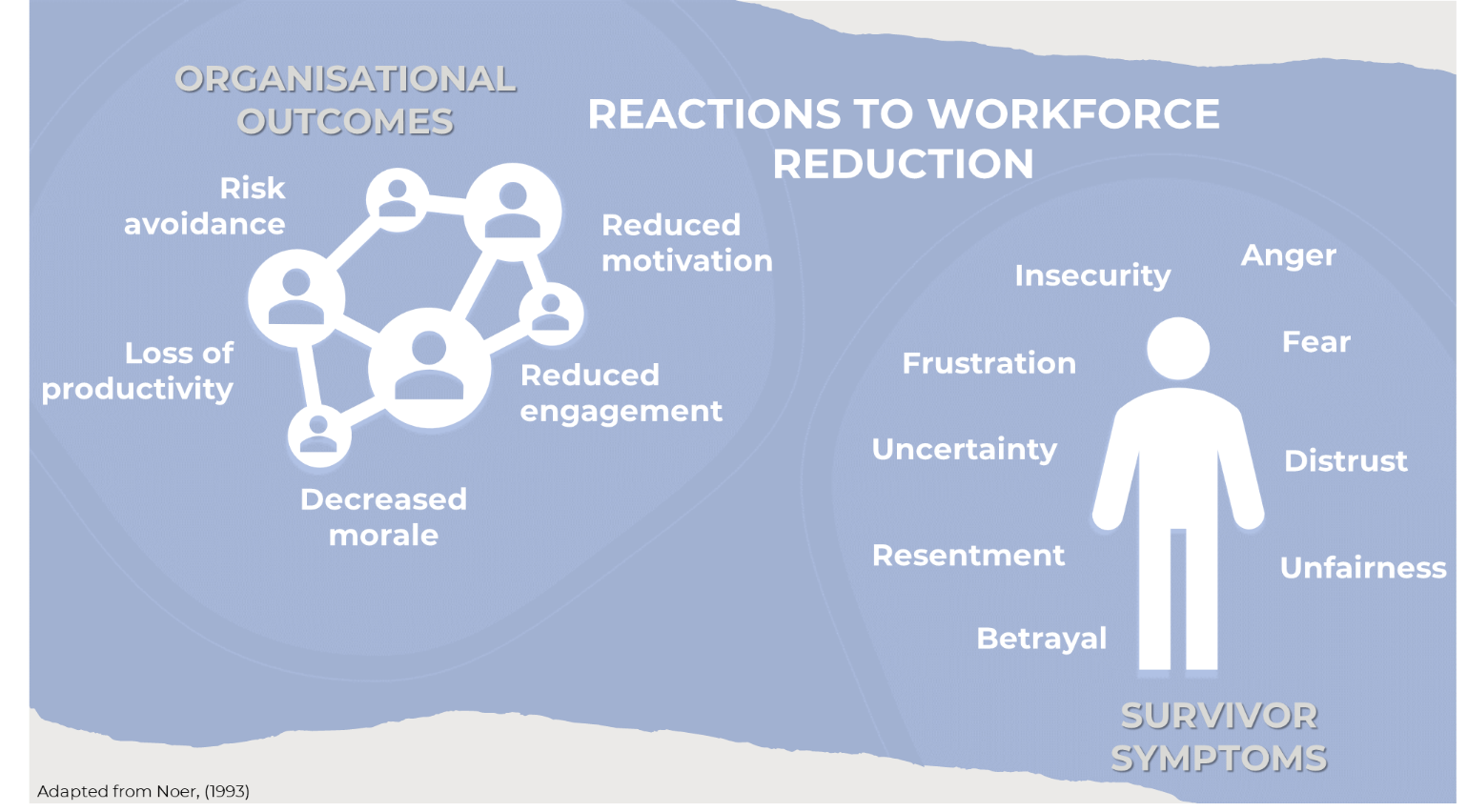When organisations ‘let people go’, the ‘lucky ones’ left behind can be affected in a profound way, often referred to as survivor guilt. Survivor guilt has been well researched in terms of people experiencing a traumatic event or a loss in their lives.
Organisational psychologists have also noticed that this occurs within organisations when people are being made redundant during job restructuring and being one of the ‘lucky ones’ left behind. Research shows that it can be, and often is, as hard on those left behind as those who have been retrenched. This is referred to as workplace survivor syndrome.
Workplace survivor syndrome is a psychological, emotional, and physical response, when a person believes that they have done something wrong in surviving retrenchment when others haven’t, leaving them with a feeling of self-guilt. Many studies show that those left behind can find it difficult. They display an increase in alcohol consumption, smoking and workplace injury, and other studies show an effect on the mental health, with reports of depression, poor morale and reduction in productivity.
In a study by Noer (1993), reactions to workforce reduction identified several key behaviours experienced by workplace survivors:

One of the effects of surviving workplace organisational downsizing is a feeling of grief. There is more than one form of grief, and this can be both at the individual and organisational level. On an organisational level, it can often be difficult to identify the effects easily. Organisational grief shows itself in the form of behaviours related to breaches in organisational trust and commitment, for example destructive types of behaviour such as reduced engagement. Those that are left behind can have a form of anticipatory grief (expecting to be next) on an individual level that can be unhealthy and lead to anxiety. This sense of grief and loss is a normal reaction to the changes and can be due to the whole reorganisational process causing confusion and disorientation. There can also be a lack of closure when workplace friends and colleagues are let go, with those left behind losing office friends and close working partners. The time following these layoffs can be very depressing.
The survivor guilt is a confused feeling of relief that it wasn’t them being laid off, plus, a sense of grief for their friends and colleagues who do not have a job. This is often accompanied by the feeling they didn’t deserve to be saved, leading to guilt. This feeling of relief and happiness for not being let go has a simultaneous effect of guilt for feeling happy; leading to what psychologists refer to as a toxic mental state.
Destructive and constructive types of survivors

Based on the reaction and responses to layoffs, Neves (2014) discussed two types of surviving employees – destructive survivors and constructive survivors. While destructive survivors focus on the negative aspect of downsizing, constructive survivors focus on the positive side of layoffs. Destructive survivors perceive the redundancy process as a threat to their job security; hence, their unwillingness to support management as it implements change in the organisation (Waraich & Bhardwarj, 2012). Often, destructive survivors portray fear and pessimism towards the reduction process, a perception that negatively impacts their productivity. Constructive survivors do not perceive the reduction process as a threat to their job and, therefore, support management by actively taking part in training and team building programs to gain knowledge on how to cope with the realignments (Neves, 2014).
These types of reactions can be demonstrated within the workplace in several different ways:
- Time Wasting
One of the side effects of survivor guilt syndrome is time wasting. This happens in one of two ways:
Employees can be either frozen or anxious, and because they become overwhelmed with the fear that they may be next, they become less productive
There is also the effect that employees are working longer hours than before but get less done. They will get their heads down and become invisible in case another round of redundancies is imminent. They will do as they are told, but the commitment to the organisation can be lost, with a lack of motivation to work hard and do good work
This disengagement is one of the greatest consequences of layoffs and leads to a workforce of, what has been described as, the ‘living dead’.
- Workers in overdrive
This is also a time when you have the employee who sees redundancies as positive for advancing their career, and be driven by success and accomplishing goals:
Employees can feel that they are more valued by the company than those that have been let go
They believe that fewer colleagues lead to less competition
They feel anger and resentment if they are overloaded with work and don’t feel as if they have been compensated fairly
If they experience poor management, frustration will build up and may cause them to move organisations.
- Employees applying for other jobs
Workers who are worried and uncertain about their future can panic after layoffs, leading them to look for other jobs and/or leave the organisation
Research shows that the effect of a longer-term feeling of vulnerability for workers, during the lead up to redundancies and the settling down post layoffs, can be worse psychologically than for those who were let go
One of the effects of this is that, if employees feel a sense of long-lasting panic, this can lead them to act out or seek an escape after work hours, e.g., alcohol.
- Panic after losing a manager
If an employee has lost their line-manager, the confusion that occurs can lead to them losing trust in the company and the person who will take over that role. This can result in feeling a need for more direction and security.
They will seek an authority figure to latch onto or find false sense of security from, and perhaps to listen to, as well as spread, gossip
This breach is often referred to as a breach in the psychological contract. The psychological contract refers to the unwritten set of expectations of the employment relationship, distinct from the formal employment contracts. If an employee is moved into a new team due to downsizing, where two teams are no longer viable, then they can feel that this is unfair wanting to know why it was them, particularly if they are not consulted about the move. Taken together, the psychological contract and the employment contract define the employer-employee relationship.
What can you do if you find yourself in this position?
One of the main coping strategies is to remain calm and not panic; Recognise that these above reactions often occur when redundancies happen.
Recognise that ‘survivor guilt’ is normal and consider ways to develop coping strategies that allow a sense of doing well, even in the smallest of things for example consider yourself in the position as a valued employee and that this will give you the opportunity to upskill.
It is important that this is recognised as a form of grief; therefore, allow the grief process to carry itself out. Look for any possible opportunities that may become available, and best of all, avoid office gossip about further cuts.







Rate and Review
Rate this article
Review this article
Log into OpenLearn to leave reviews and join in the conversation.
Article reviews